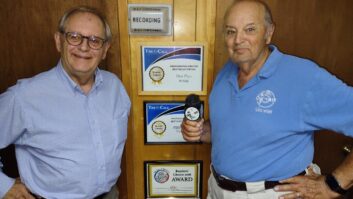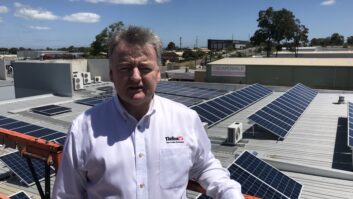
SAN FRANCISCO In a move designed both to reduce dependency on the power grid and to showcase renewable energy, KGO(AM) in San Francisco, transmitting on 810 kHz, recently completed installation of a solar power system at its transmitter site. The station now also expects to become a test bed for PG&E partners and SolFocus.
In a ceremony on Oct. 30, Speaker of the House Rep. Nancy Pelosi threw the switch to inaugurate renewable energy at the Citadel news/talker.
Located on the eastern side of the Dumbarton Bridge, KGO’s transmitter building is seen by 80,000 commuters every day, according to a station spokesperson, providing a high-visibility location that helps calls attention to the latest in solar power technology.
The project is the outcome of a longstanding relationship between KGO and Pacific Gas and Electric Co.
“We have a partnership with PG&E to communicate with their customers in emergencies. I visited them recently and asked what we could do to save energy at the transmitter site,” said KGO General Manager Mickey Luckoff.
“They were very enthusiastic about solar, and helped us assemble a team of contractors and suppliers, including SolFocus.”
SolFocus is a startup company in Mountain View, Calif., that develops and manufacturers concentrator photovoltaic (CPV) solar cells.

Three arrays of concentrator photovoltaic cells track the sun at the KGO transmitter site. Flat solar panels are located on the roof of the transmitter building and garage, and on the ground. Photo by Art Lebermann, KGO KGO became involved in the green movement several years ago, first with internal projects such as recycling, gradually adding green initiatives in programming and on the station Web site.
The KGO project is a hybrid of traditional flat-panel and cutting-edge concentrator photovoltaic technology (see sidebar). The installation costs were about $250,000, a little higher than expected, according to Talbot, due to the unusual location next to a public highway and in a salt pond.
KGO will get about $33,000 back from the state through a solar incentive program, and between $30,000 to $40,000 back over several years in the form of federal tax credits. It projects savings of around $3,000 annually on its utility bill.
“We get about 7,300 watts from three CPV cells on trackers, which enable the cells to follow the sun on two axes. The remainder comes from GE flat panels installed by Premier Power, which are ground-mounted and installed on the roof of the transmitter building and garage,” said Director of Engineering Joe Talbot.
He adds that the approximately 20 kW total limit is a result of the relatively small amount of real estate available on the site.
The flat-panel portion of the installation consists of fifty 200 Wp (Watt-peak) GE solar modules, yielding a 10 kilowatt-peak system capacity. The SolFocus portion of the installation uses three 12-panel CPV arrays rated at 2.46 kW each for a total of 7.38 kW.
The array uses a recently-designed SolFocus/Inspira tracker and controller.
The system is simple. Both solar arrays feed inverters that go directly to the building AC, reducing power demand from PG&E. Since the load always exceeds the supply, there is no need to store power in batteries.

Sunlight enters from the top, striking the primary mirror. The light is reflected to the secondary mirror, then concentrated onto a 1 mm triple-junction cell which is optically coupled to the glass. The design results in a smaller, thin, flat, molded glass CPV tile. The two solar systems at KGO complement each other. Traditional flat-panel arrays do not require direct sunlight, and can generate power on cloudy days. Since they do not require trackers, they can be mounted on rooftops.
Concentrator photovoltaic panels are more efficient than flat panels, but can only operate when pointed towards direct sunlight, necessitating the use of trackers, and making them unusable on overcast days.
Talbot adds that the real complexity comes with the control and monitoring of the system. “The systems installed by SolFocus and Premier Power have incompatible control systems, since there are no standards for monitoring solar systems yet. The two are connected through a gateway.” Premier Power installed the flat-panel portion of the project.
Talbot said initial concerns about the installation of the panels and controllers in a high RF field proved to be unfounded. “We had ferrite beads and capacitors handy to filter out RF, but didn’t need to use them.”
“The trackers are microprocessor-controlled, so it’s certainly prudent to consider the RF environment and its impact on computers and controllers. If you can make a microprocessor-based remote control work in your RF field, then you should have no trouble with this technology.”
About CPV Cells Most solar cells in use today are flat-plate PV, which produce electricity when sunlight strikes panels lined with sheets of costly photovoltaic cell material. This technology, with some refinements, has been in use since the inception of solar power about 30 years ago, according to SolFocus.
Concentrator photovoltaic (CPV) technology, recently developed at the Palo Alto Research Center in conjunction with SolFocus, achieves greater efficiency by using mirrors or lenses to concentrate solar energy onto smaller areas of PV material. Additionally, CPV technology uses multi-junction, or ‘III-V’ solar cells.
These new cells convert energy more efficiently than traditional solar cells, approximately 35 percent today, with expectations of 45 percent as the technology is further refined, according to SolFocus. These efficiencies contrast with typically 13 to 18 percent efficiency for silicon cells.
CPV arrays work by focusing sunlight onto a small area of silicon. The arrays must be pointed directly at the sun to achieve maximum efficiency.
This necessitates the use of trackers, which follow the sun’s trajectory throughout the day. Trackers historically have been expensive and unreliable, but recent advances have produced lightweight, reliable devices enabling rooftop installations producing from 10 to 100 kW of electricity.
The SolFocus CPV modules claim to halve costs and operate at double the efficiency of average flat-plate PV panels. The modules also use glass, which has a 30-year life span, and they have dry, passive cooling, requiring no liquids or fans. The modules have one-quarter the focal length of other systems, making them compact.
— Tom Vernon
Maintenance on the solar system is expected to be easy. “Basically it’s a matter of washing the panels periodically to clean up after the seagulls and remove accumulated dirt.” Power output from the cells decreases as grime accumulates, Talbot said.
“We also need to grease the tracking mechanism for the CPV arrays,” according to Talbot, who adds that a more refined program may be worked out as they spend time with the system.
The installation also marks the beginning of a long-term relationship for the station with SolFocus and PG&E to use the site as a test bed for emerging solar technology.
“We’ll be looking at what’s offered to us by anyone who partners with PG&E, and expect to see a lot of ongoing R&D projects with SolFocus,” according to Talbot.
KGO announced the solar project in February. Talbot and Transmitter Engineer Art Lebermann supervised the installation. Lebermann maintained a solar blog with progress reports and photos: dynamic.kgoradio.com/solar.php.
Work was scheduled to be completed by mid-March, but rains delayed pouring the concrete foundations and other outside construction. Progress was later slowed, according to a SolFocus spokesperson, when the company updated the solar tracking technology used in the installation.
The construction work drew interest from commuters on the adjacent Dumbarton Bridge. “Many of these people grew up in the Bay Area, and have a keen interest in everything the station does,” said Talbot. “We received a number of phone calls and e-mail inquiries, and it’s going to be a great avenue to promote the station and what it’s doing with solar power.”
Other efforts to “green” the KGO transmitter site are under consideration, according to Talbot. A more efficient air conditioning system may be installed to replace the current one, which was designed to handle the building’s original Harris MW-50 transmitters.
Talbot said the heat load from the current Nautel transmitters is much less than the older units. Also under consideration is a plan to replace lamps in the beacons on the station’s three-tower array with LEDs.







